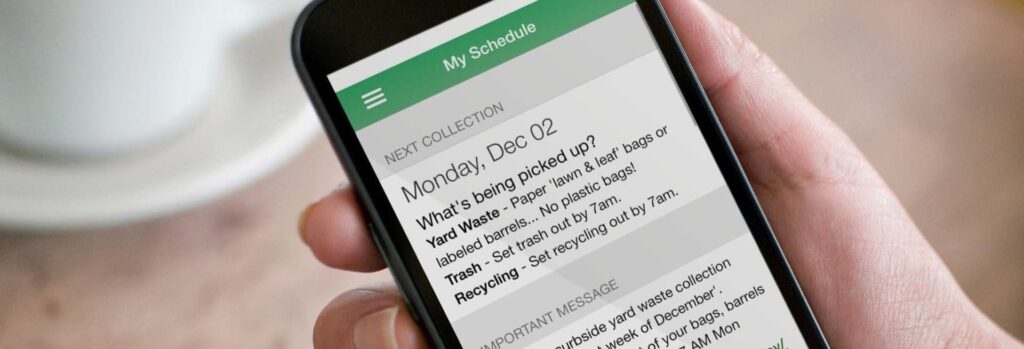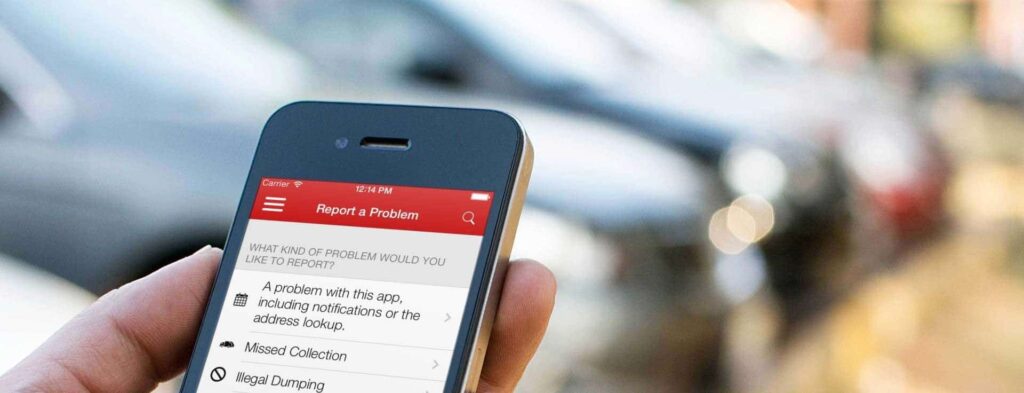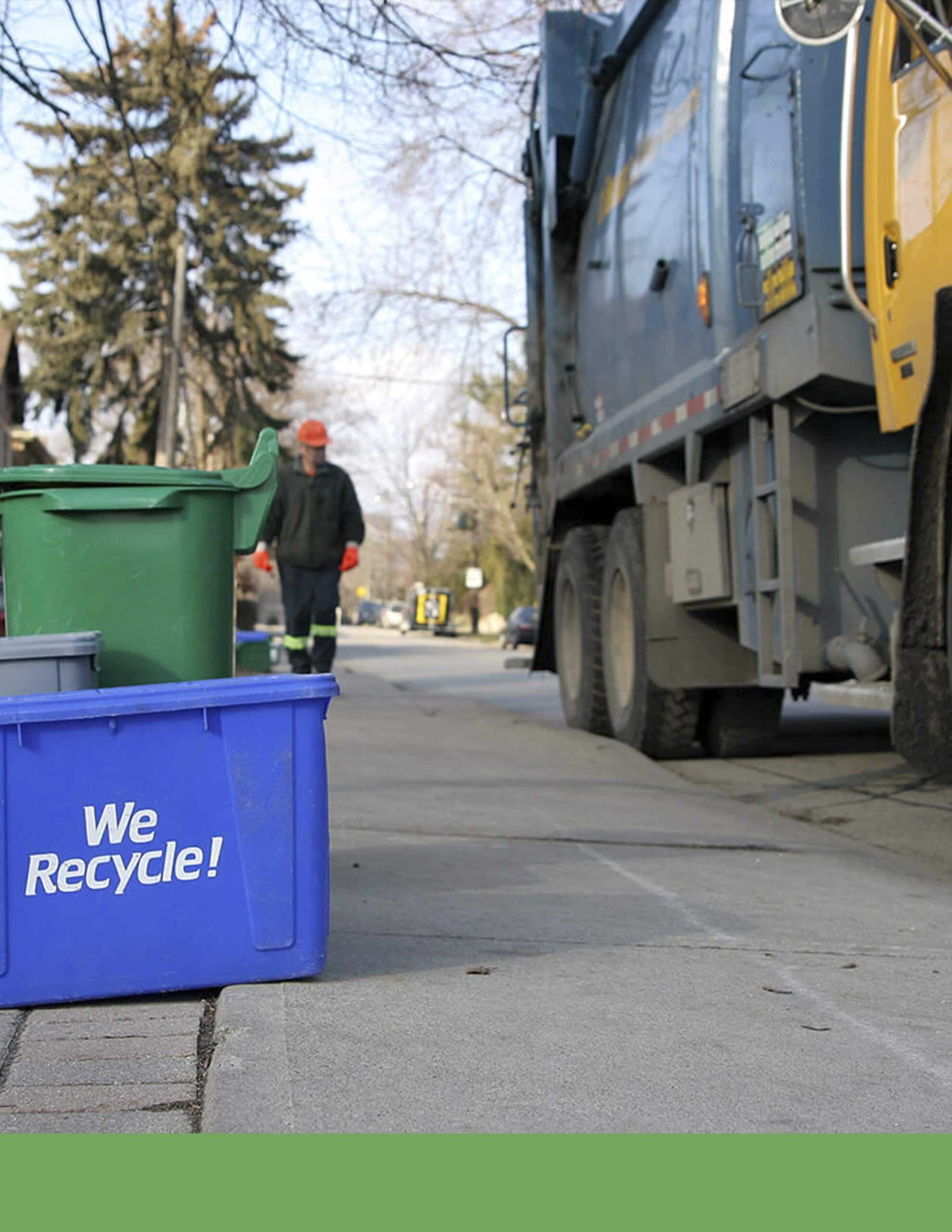Introduction: The What and Why of Waste & Recycling Communications Tools for Haulers
Strapped for time? Download this guide and read when you have time.
Connecting with customers in a helpful, respectful way is easy when you use the right tools
Key Takeaways
- Using waste communications software allows customers to obtain the information they need when they need it
- Customers who have easy access to information are able to make better decisions about what to recycle, which helps reduce contamination costs
- Proactive messaging through digital tools can reduce call volume
How do you communicate with customers about waste and recycling services? Whether you send out a monthly letter, put ads in the local paper, or send out mass email blasts, your customers are getting messages from you somehow. Whether the message says “recycling is important and we’re here to help you” or “do what you can, but you’re on your own” is up to you.
Software is not the answer to every customer communications dilemma, but it helps immensely with mass communications. If you want to reduce contamination, reduce call volume around service disruptions, or simply enhance the customer experience, software is your friend. It doesn’t have to be difficult, and it doesn’t have to be costly. This guide takes you through everything you need to know about purchasing waste and recycling communications software.

Chapter 1: Why Buy Waste & Recycling Communications Software?
Help your customers get it right by modernizing your approach to communications
Key takeaways
- Keep customers up to date on collection changes and service disruptions
- Reduce call volume and recycling contamination by making information easily accessible
- Enhance the customer experience with modern digital tools
Why are you looking at communications technology for your program? At ReCollect, we hear lots of different stories, but these are the most common among them:
You Are Planning a Change in Collection Services
Countless ReCollect customers have come to us to help them reach customers about changes in service. Some have needed to entirely revamp their recycling program with new rules or added streams. Others are looking to implement new services such as yard waste collection or on-call bulky item programs. Whatever the case, keeping customers engaged and attentive to these changes can be challenging. Our digital services and give your customers the information they need, when they need it.
You Want to Reduce Call Volume
One of the key impacts of going digital is getting a handle on calls into your customer service line. On normal days, you might be able to answer all of the calls quickly and easily. But on other days, call volumes can rise exponentially because of weather events or other unforeseen circumstances. You may even think some calls could be avoided entirely, such as “When is my collection day?” or “Can I recycle styrofoam?”.
Whatever the case, customer service calls are expensive. In North America, the average call to a customer service line costs $3.14 in time and resources. Some less efficient call centers have even reported inquiries costing over $5.00 per call. Very often this important metric isn’t even measured in private hauling operations.
You Want to Reduce Contamination Rates
Contamination is costly, period. If your recyclables are being processed by a third-party MRF, you run the risk of hefty fines or rejected loads for exceeding contamination thresholds. If you are a MRF operator, you are certainly aware of the time and resources required to remove contaminants from the stream, process them, and send them to the landfill. On top of all of this, contaminated bales are nearly impossible to move in the marketplace. No matter how you cut it, contamination takes away from your bottom line and requires a customer communications strategy.
Your Organization Is Looking to Enhance the Customer Experience
Do you associate the words “waste and recycling service” with “satisfied customer”? We do. At ReCollect, we measure how engaged customers are with our products because it is integral to our success. Happy customers do a lot for your bottom line: they’re more likely to listen to your guidelines and messaging, less likely to make unnecessary calls, and will trust messages that come from you in the future. Digital communications tools can sharpen program delivery in numerous ways, and set you apart from the competition.

Chapter 2: Making Sure Your Technology Choices Stay Relevant
A common question we hear: “Can’t my IT department build this for me?” Read on for some SaaS 101 and why businesses are increasingly choosing cloud-based software vendors over building their own
Key Takeaways
SaaS is incredibly helpful for four major reasons:
- Quality: the provider is (usually) a specialist in providing the service
- Reliability: they can operate the technology better than I can do it myself
- Security: they can do a better job of securing hardware than I could
- Price: they can do all of this cheaper than I can
What is SaaS?
Software as a Service, or SaaS, is technology that is delivered via subscription. You access the product with an internet connection and log into the company’s platform on your computer, smartphone, or tablet. Popular examples of SaaS include Salesforce, Evernote, and even Netflix. In fact, it is possible that you’re already using SaaS if you have a modern CRM system like Trux or Soft-Pak: your CRM provider stores your routes and user data in “the cloud” and you access this data via a login to their platform.
What Is “The Cloud”?
Very simply, the cloud is: “other people’s computers.” Internet servers are big, hot, and complex, and they do best when managed by specialists. There are a number of reasons why SaaS via the cloud is helpful, including:
Back-up servers. This keeps your data from being lost in the event that a server goes down.
Security. When servers are managed by the provider, they have highly trained staff on hand whose sole job is to address and fix failures very quickly.
Why is SaaS so popular?
With SaaS, subscribers can now access technologies that used to be cost-prohibitive. If a private hauler wanted a custom in-house app made 5 years ago, it would take a small army of technically trained staff as well as tens of thousands of dollars in upfront costs to make it happen– and that’s only for version 1.0. The same team would then be tasked with constantly updating new versions for maintenance and bug fixes as issues in the app are found.
With SaaS, there is no updating these “versions” because the work is done for you:
- Development of new features
- Maintenance to keep things running smoothly
- Security updates, bug fixes, and everything else
All you need to do is remember your username and password.
The Cost of SaaS
The subscription model of SaaS sometime makes people pause. “Wait,” they say, “I have to keep paying for this? Why can’t I just pay you once?”
The model of SaaS should explain itself:
- Customers pay a lower fee more frequently to have constant access to a top of the line product.
- You have guarantees on how it looks, feels, and functions.
- If it doesn’t meet your needs or underperforms in some way, you can wash your hands of the product and move on, no strings attached.
This not only ensures quality solutions for the customer, but it makes much more affordable in the long run. The alternative to SaaS is developing tech solutions in- house, which poses heavy financial investment. In-house development means in-house management; if you choose this route, you are responsible for the constant cycle of managing and updating software. And if your final product doesn’t function how you want it to, that means a lot of wasted time and resources.
With SaaS your product is guaranteed, and your system admins and IT staff aren’t bogged down by constant development, upkeep and maintenance, allowing them to put their time to better use in other areas.

Chapter 3: Maintaining Your Brand: The Importance of White Labeling
Does your app vendor put their own brand ahead of yours? With ReCollect, you can fully own the medium, the message, and the data.
Key takeaways
- White labeling allows you to maintain your brand
- When you control the branding you are able to seamlessly switch vendors if you are dissatisfied with the results
- White labeling builds credibility and makes it easier for your customers to determine if the information they are receiving is from a credible source
In a nutshell, white labeling is the act of taking technology and branding it as your own.
Your brand is your best friend. It offers credibility, consistency, and control over messaging. It allows you to build trust, share strong messages, and experiment with programs. A strong brand delivers results with compound interest: the more you work with it, the stronger it becomes.
Do You Need a White Labeled App?
We’re often asked about white labeling and why it matters. When you need an app, you can get it in one of three ways:
- Build it yourself
- Subscribe to a full-service application
- Subscribe to the technology that allows you to control your brand and messaging
For each of these services, there are pros and cons to consider:
Software Considerations: The easiest way to get great software is to get specialists to build it for you. But, don’t just evaluate for the initial build: software and hardware technology changes fast, and you’ll want to keep up with changes. Whether you’re looking at building software in-house or getting it built or provided to you, you’ll want to make sure the developers can maintain the software.
You Want to Own Your Data: To communicate with customers, you often collect information about them. It’s important to make sure that you own this data. This allows you to change vendors at any point without disruption, but most importantly, it means that the vendor cannot share this data with third parties without you directly consenting to and enabling that.
Manage Your Brand: We know that multiple groups of recycling activists, businesses, and technology companies are trying to offer information to the public about ‘what goes where’. But rules on what is locally recyclable vary. Without a managed communications strategy, messages quickly become watered down, or worse, conflicting. If your goal is to reduce waste stream contamination, white labeling gives you the credibility you need to reliably convey this information. Your brand is your message– this is a powerful tool to build trust with your customers as the only source of information they need.

Chapter 4: Web Accessibility is the Law, and the Right Thing to Do
1 in 5 North Americans live with some sort of disability. The right technology can help, not hinder, service for them. Make sure your vendor is providing software that is accessible for all of your customers.
Key takeaways:
- Web accessibility allows you to connect with more customers
- More and more jurisdictions are making web accessibility a legal requirement
- Have your website audited by an accessibility auditor to ensure that your web technology meets accessibility standards
According to recent census data, more than one-fifth of the US population reports being affected by a disability. In the same way that a wheelchair entrance allows people with mobility impairments to access a building, adhering to web accessibility standards is vitally important to ensuring that people with many types of disabilities are able to interact with services online. With ReCollect, you can provide essential services that make everyday lives just a little bit easier.
Impact of Accessible Service
The Web Content Accessibility Guidelines (WCAG) 2.0 have become the internationally accepted standard for providing content on the internet in a way that is accessible to people with disabilities. This includes making sure that images have proper descriptions that allow them to be understood by visually impaired citizens, or making sure that people with neurological disabilities that affect their dexterity can easily navigate websites using a keyboard when a mouse is too difficult to use.
These reasons and more mean that there has never been a better time for us to care about accessibility in our online society.
It May Be A Legal Requirement
Is your website visited by customers with disabilities? The answer is definitely yes. This should be enough of a reason to offer accessible tools. But if you need a bit of a nudge, there are consequences for not doing so, too. If you are supplying a web app or mobile app to a city or town via government contract, you may be required by law to provide accessible software.
More and more jurisdictions are passing laws that dictate minimum accessibility standards. If you do end up in this scenario, you could be at risk of getting sued by your local accessibility advocacy group.
Change People’s Lives for the Better
In the end, accessibility is not just about meeting some guidelines. It’s about making sure that everyone you provide services to feel supported. With the right tools, you can help someone accomplish something they’ve never been able to do before.
How to Ensure You Are Providing Accessibility Compliant Online Services
The best way to ensure that your web technology meets accessibility standards is to have your website audited by an accessibility auditor.
But if you’re not prepared for an audit right now, then make sure to select vendors who have already gone through an audit process. And remember to request some level of documentation of that audit process. And remember to request some level of documentation of that audit, or get your IT team to run an assessment. Make sure the vendor has done the work to be accessibility compliant; don’t just take their word for it.
For instance, our tool is regularly audited to achieve Web Content Accessibility Guidelines (WCAG) level 2. For more information about WCAG, please visit: https://www.w3.org/WAI/intro/wcag

Chapter 5: Data Ownership and Privacy
At ReCollect, we consider ourselves custodians of your data, not owners. When looking for a software vendor make sure you read the fine print regarding data ownership
Key Takeaways:
- There are three types of data: operational data, user information and exhaust data
- Whoever owns the data determines the privacy policy, so ask questions during the sales process to ensure you and your customer data is kept safe
- Look for high privacy standards and ask about third-party privacy audits
People care about their privacy. Technology services are meant to be consistent and safe. Unsolicited marketing and scams make people very upset.
When companies don’t keep data private, there can be real consequences. Technology companies must be extra vigilant with privacy, and buyers of their software must pay attention to vendor privacy policies. Unfortunately, procurement processes don’t always cover it. Here, we give the basics of technology privacy.
There are three main ways a software provider can commit to privacy:
- Commit to high standards. The company should be willing to go above and beyond keeping users’ data private.
- Organize their business operations to constantly ensure privacy. This might include, for instance, deleting data as soon as it is no longer needed. Data that is unnecessarily stored can be forgotten and left vulnerable.
- Keep private data secure (Covered in Chapter 6)
Look for High Privacy Standards
How can you tell if a company is committed to data privacy? In privacy, the biggest signal is the business model of the company. If their products are free or very low cost, they may be subsidizing access to the product in exchange for selling or monetizing the content later.
We put a great deal of thought into privacy. Our development team puts aside resources every quarter to ensure high privacy standards. Famed data expert Maciej Ceglowski has this simple advice when it comes to data privacy policies:
- Ideally, don’t collect it.
- If you have to collect it, don’t store it.
- If you have to store it, don’t keep it.
ReCollect has been built with these principles in mind. ReCollect intentionally collects as little Personally Identifiable Information (PII) as possible to provide the service. Our team has also put a lot of effort into discarding and deleting data as soon as is practical so that we are not storing PII more than absolutely necessary (We have an industry-leading privacy policy of deleting all unused sensitive data after 90 days).
Having high privacy standards often also includes regular third-party security audits, these help to enforce good privacy. If your software provider can provide certification of recent audits, that’s a good sign that they care about data privacy. We highly suggest you ask for privacy guidelines and ask for third party audits.
Who “Owns” Your Data?
Every app collects data about its users. This data may include street addresses, emails, and phone numbers and other service details. Whoever owns this data determines the privacy policy.
Whoever owns the data can do three things that could affect you:
- They can change the privacy policy
- They can sell data to third parties
- They can use the data for their own purposes, counter to your interests
These are common enough that they should cause concern.
Types of Data
There are three main types of data to maintain ownership over:
- Operational data: In a software relationship, this is the data that the hauler provides. It might include data like waste collection schedules, geospatial data like parcel address maps, or educational materials like recycling guides. What happens to this data when you move software vendors? At a minimum, it should be deleted from the software vendor servers.
- User Information: This data comes from customers who sign up for the software program. It is the most valuable type of data, and is the stuff you’d want to export when parting ways with a vendor. If you don’t own this data, you could lose it, it could be sold to third parties, or it could be used in ways you do not control. Ask: does the vendor expect to retain a copy of user info?
- “Exhaust” data: These are the analytics that accompany the software (number of pageviews, for instance). This is harder to transport between systems because every app is architected differently. But these are the operational statistics that you can use to guide future use of the app. You should expect a vendor to export and delete that data at termination.
Will you ever get your data back? Will the vendor delete data you own when you terminate the service? Ask! It’s the only way to find out.

Chapter 6: Web Security and Keeping Your Systems Safe
Customer data is the prized possession of any business. Protect it.
Key Takeaways:
- Without good security, attackers can access user data and abuse it
- Ask vendors questions about third-party security audits as soon as possible
- Ensure unneeded data is deleted as soon as possible
- Have and know the plan for a data breach
- Find out what happens to data if you terminate a contract with a vendor
Trusted security must be a requirement for all business software tools. Unfortunately, it’s hard for everyone to know what good security and privacy looks like. Evaluating privacy and security doesn’t have to be complicated. And it starts with one key question…
What Can Happen If Your Security Fails?
The simplest reason to have good security is that without it, attackers can access user information and abuse your trusted relationship with them.
There is always uncertainty about what could go wrong, and your customers expect personal data to be kept safe. We all want to know that our personal information will be used only for the purpose it was provided for. We also want to know that the data won’t be kept forever — but will be responsibly deleted once use is complete.
If that isn’t enough to convince you to have good security, here are some precise threats to the kind of software solutions that ReCollect makes:
Web-based Embedded Widgets Security
When you embed a JavaScript widget on your website, you are implicitly putting trust in that vendor to keep your systems secure. Through incompetence or malice, the vendor could put the website at risk. Visitors to the website widget could be subject to attacks if the widgets or service become compromised. These attacks could trick you or your customers into many inappropriate and harmful activities including:
- Sending inappropriate messages to users
- Defacing website content
- Taking the trust in the company website and abusing to gain access to other accounts (aka Phishing)
- Collection and storage of Personally Identifiable Information (PII) in insecure ways that leave it susceptible to theft
Mobile Apps Security
Without proper security, mobile apps are vulnerable to theft of PII and other sensitive data. This is particularly of concern because of the nature of mobile devices — they are always with you, and have sensors like GPS, cameras and microphones.
Admin Portal Security
Improper security controls could give attackers access to administrative tools, could cause inappropriate communications, data theft and data loss. The risks with technology that collects personal information are significant, and you should choose a vendor with expertise and experience building secure internet facing products.
In addition, the ability to detect and respond to threats quickly is critical. When new vulnerabilities come out (as they often do), vendors need to be in the loop and have the resources and skills to quickly patch their systems.
How Can You Tell Whether a Vendor Adheres to a Good Standard for Privacy or Security?
Third-Party Audits
Before you even look for a quote, we suggest you ask your salesperson these four questions:
- Has the software been reviewed by a third-party audit?
- How frequently is the system audited?
- When was the last audit?
- Can a copy of the conclusions be provided?
ReCollect conducts regular security audits and can provide these to clients. Also, ReCollect has worked with clients in the past to conduct joint detailed security audits related to the specific customer implementation.
How Do You Keep the Data up to Date?
By default, ReCollect adopts an aggressive 90-day policy on data retention. ReCollect deletes any Personal or Operational data that is no longer in use after 90 days, and deletes Exhaust Data retained for auditing and debugging after 90 days.
ReCollect is prepared to comply with any requests for custom data exports. Many of these requests can be made by clients directly through the administrative dashboard. And if you can’t find what you’re looking for, we’re happy to help get you the data you need as part of our service.
What Is the Plan for a Data Breach?
The ability for a vendor to respond to a data breach is hard to discern because it’s easy to say “we’ll notify you,” but it’s hard to validate. You could ask to see their internal process and an example of the last time it was used. In our case, we use a 13 step incidence protocol.
ReCollect commits to directly contacting the designated officers/staff if it is determined and discovered that we have experienced a data breach.
ReCollect’s Customer Notification Process is used whenever a security or downtime incident happens, however minor. ReCollect Operations Staff follow this process to identify information, perform initial resolution steps, and escalate to the ReCollect Executive Team.
The ReCollect Executive team reviews the incident and communicates the impact severity of the incident to the data owner, as required by our subscription agreement. This notification happens via email, or phone if the notification is time sensitive.
ReCollect has never lost customer data or had a security breach. Should such an incident happen, in-kind services would be given in accordance with our Subscription Policy.
What Happens to the Data if You Terminate a Vendor’s Contract?
If you terminate a relationship with a vendor, you’ll want confirmation that they will return your data and delete it from their services. If they cannot confirm this, it is possible that the vendor can legally use the data for their own services in the future
This is more or less serious depending on the type of data they keep. Do you want to keep exclusive rights to:
- Your operational data including your waste collection schedules, local recycling rules, etc.?
- Users’ personally identifiable information the vendor collects from customer usage?
- The analytics and reports the vendor offers on app usage?
ReCollect has among the strongest data exiting strategies in the software industry. Within 10 business days of the termination of the relationship, ReCollect provides their customers with a copy of all personal information from our systems. We offer deletion of our customers’ operational data, and export analytics and reports at the customer’s request at no extra charge.
Security Auditors
This bears repeating: it’s best practice to hire a security auditor. Altius IT, ReCollect’s systems auditor, is certified by the Information System Audit and Control Association (ISACA) as a Certified Information Systems Auditor, certified in Risk and Information Systems Controls (CRISC), and Certified in the Governance of Enterprise IT (CGEIT).
We highly recommended that you ask your technology vendor to supply you with a security audit of their systems. This keeps you and your data safe over time, and ensures you are getting a quality product.
Learn More
ReCollect is a digital communications company that serves the waste and recycling industry. We keep clients connected to more residents by following the Web Content Accessibility Guidelines, ensuring your data stays safe with regular third party audits and work closely with you to help meet your communication goals. Our unique communication tools help towns, cities and private haulers like you reduce call volumes, increase operational efficiency and increase diversion. Want to learn more?

Let’s start with a 20 minute connect call to learn more about your organization and see how we can work together to meet your waste program goals with better communication.





